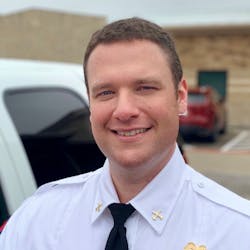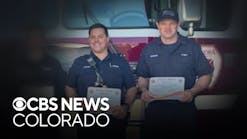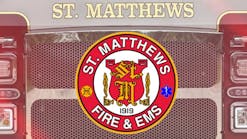The new fire officer may have attained their position through long hours of study, years of education and training, and hard experience. The smart new fire officer knows this is only a starting point. There are a number of tools and programs providing guidance and development for officers at the mid-career level. This was not the case a few years ago. Through the efforts of national and international fire service organizations, we now have new opportunities our predecessors could only wish for.
The first question for you, the new or aspiring officer, is about intentions. We all know that as we grow, our plans and desires change. Common is the firefighter who thought they’d never want off the back step, but years into a career discovered different ambitions. Sadly, many of these firefighters find themselves unprepared for opportunities and regret decisions made years before.
The wise course for you, your family and your agency is to prepare today for a number of possibilities. So, ask yourself what you want out of the rest of your career. Is it to be chief? Fire marshal? Training officer? Or do you think you’ll probably retire as a company officer? There is no right answer to these questions. Asking the questions and following them through to their conclusions is the point. The commonality between every possible answer is the conclusion that you are not done with your journey!
Your roadmap
No matter what you decide about your future, the first place I advise looking for next steps is the IAFC Officer Development Handbook, currently in its second edition. In the Handbook, you’ll find a roadmap for training, education, experience and self-development corresponding to rungs on the career ladder.
At this point, you’re probably in, or aspiring to enter, the supervising or managing fire officer part of your career. The Handbook offers a framework that includes certifications, such as Fire Officer I and II and Incident Safety Officer, education including certain associate’s-level college courses, and some competencies appropriate for your career level. Even if you decide to stay at the company or managing officer level for the rest of your career, you can ensure that you’re one of the best by following these best practices. The higher career levels included in the Handbook are useful as a roadmap should you decide to pursue further advancement.
Development programs and accreditation
Next, check with your state fire service training agency and the National Fire Academy for guidance. Any program provided by these agencies should be reputable. Some state agencies offer fire officer training programs resulting in NFPA-compliant certifications or credentials that carry weight in your state or region.
The National Fire Academy (NFA), in particular, is at the forefront of training at your career level. You may be familiar with the decades-old Executive Fire Officer program at the NFA. Recently this model of professional development was expanded down the career ladder. The Managing Officer Program opened classes in 2015 as the first comprehensive national mid-career training program. Students complete a series of prerequisite courses in their home states, then attend four six-day courses on campus in Emmitsburg, MD. The program ends with capstone projects bringing what they learned to their home departments. Along the way the students gain a broader perspective on the industry and make connections with like-minded professionals that often last for life.
One prerequisite for the Managing Officer Program is 60 accredited college hours. When you pursue higher education and training, you must be a discerning consumer. Many programs advertise or sponsor various fire service events, publications and organizations, but this isn’t necessarily a measure of their quality or even legitimacy. You must find the best fit for you and your desires but, more important than that is accreditation and recognition. Some firefighters have spent significant time and money taking classes only to find that the credit won’t transfer, or the training isn’t recognized because the institution isn’t accredited or has a poor reputation.
Accreditation is an important issue in higher education, and you must understand what it means for you. The U.S. Department of Education oversees several independent accreditation organizations, with the goal being to “ensure that education provided by institutions of higher education meets acceptable levels of quality.” This is a minimum, through-the-door standard roughly analogous to a Firefighter I certification in our industry. The upshot for you is that you should only attend college courses provided by an accredited institution. Should you attend a non-accredited institution, you will find your chances for financial aid limited and will likely discover your credit is all but worthless. To verify a college’s accreditation or find more information on what it all means, you can find extensive information on the Department of Education’s website.
Credentialing
After you’ve started this journey, you may find it helpful to pursue a professional credential. Credentialing is a comprehensive process that compares your experiences and competencies against an accepted standard that goes beyond minimum expectations. The credentialing process itself provides a roadmap exceeding that found in the IAFC Officer Development Handbook and other models. Those who attain a credential have demonstrated a commitment to lifelong improvement and professionalism.
There are two major credentialing organizations serving the North American fire service, one based in the United States and one based in the United Kingdom. The first and most common is the Center for Public Safety Excellence (CPSE), sometimes known by the name of a sub-unit called the Commission on Fire Accreditation International.
CPSE offers several credentialing programs: Chief Fire Officer, Chief EMS Officer, Chief Training Officer, Fire Marshal and Fire Officer. Check the CPSE’s website to download an assessment packet and get an idea of what your next steps may be.
The second credentialing organization serving North America is the Institute of Fire Engineers (IFE). This is an older organization, founded in 1918, from the United Kingdom. It awards “grades” of credentials to fire service professionals. In many Anglophone countries, its influence is considerable, but in the United States and Canada, it hasn’t made as many inroads. That may be changing, as it has developed a reciprocal relationship with CPSE and a growing American branch. Nevertheless, it provides a useful look at what our brothers and sisters across the Atlantic consider essential for professional growth. Check out the IFE website and the U.S. and Canadian branches’ counterpart sites for further information.
Find your own path
This is a very limited survey of the landscape. As you explore these professional development opportunities, you will discover side roads that you may wish to explore. It’s a big world with a lot of variety. Even within the fire service there is something for nearly everyone. It’s up to you to find the right path to fulfillment and a fulfilling and productive career.

Patrick Mahoney
Patrick S. Mahoney, M.S., is a battalion chief with the Baytown, TX, Fire Department. He has been in the fire service since 1998 in both career and volunteer fire departments, and has worked as a company officer, training and safety officer, and shift commander. He currently serves on the Board of Directors of the Company Officers Section of the International Association of Fire Chiefs (IAFC).






